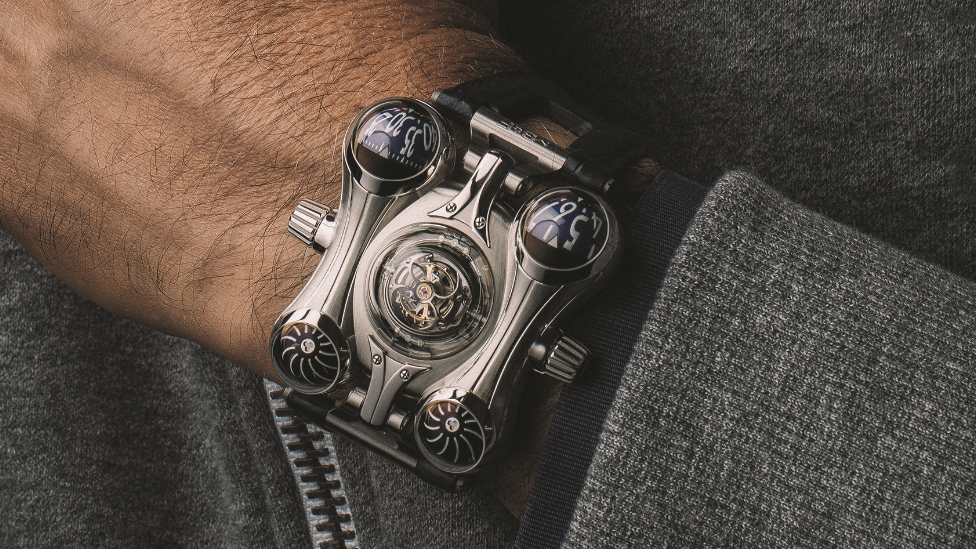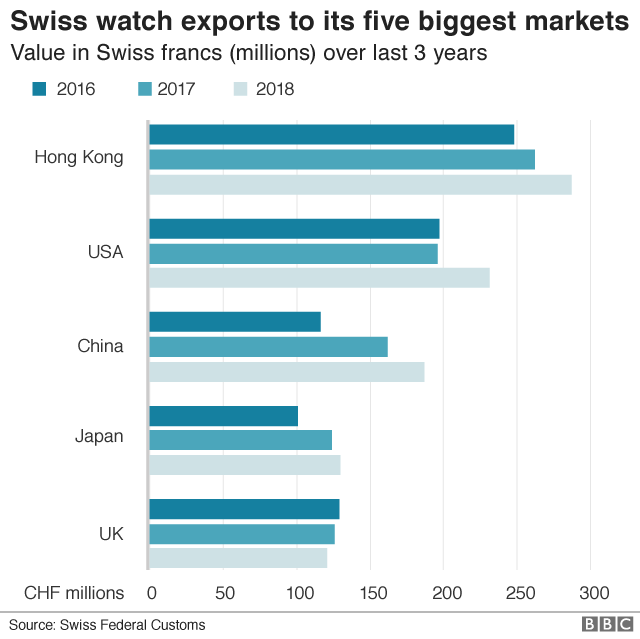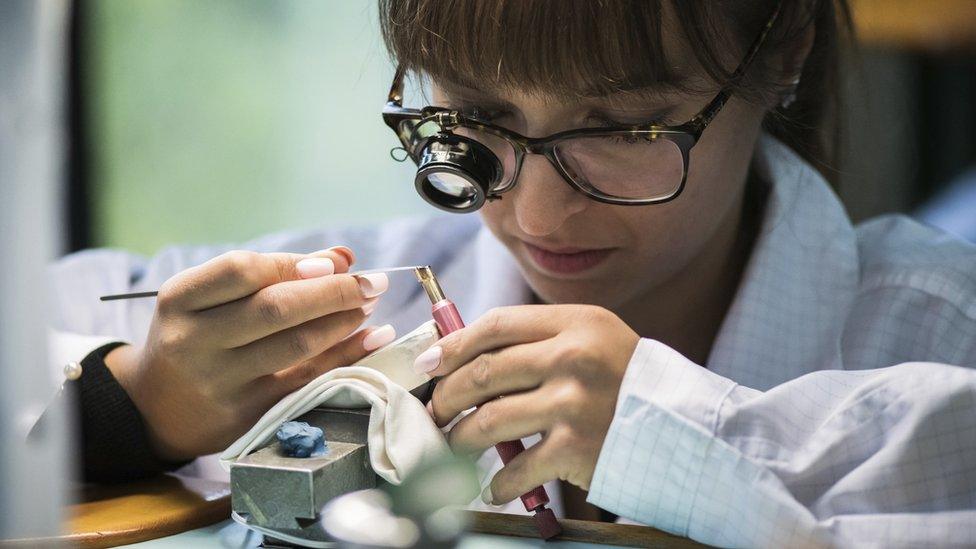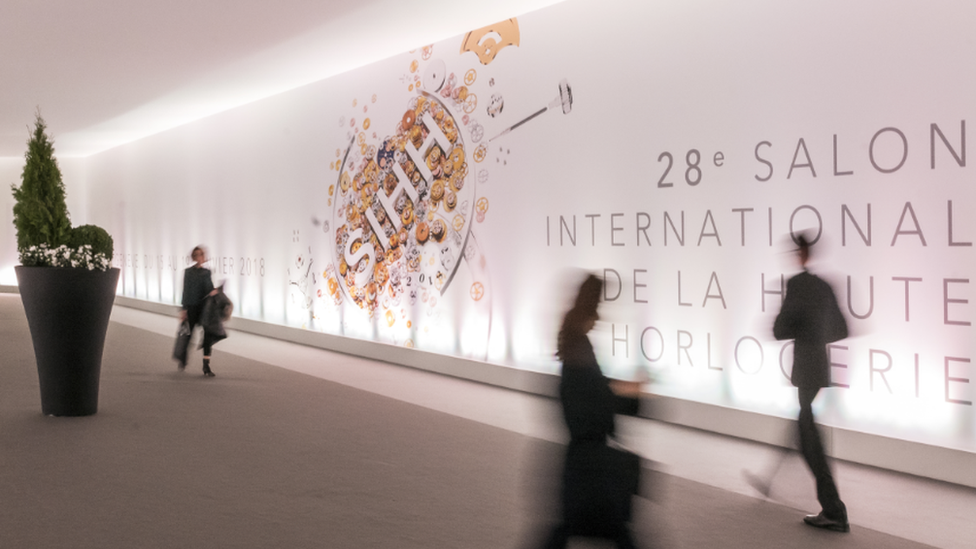Watch industry's times are changing
- Published

Fabienne Lupo, head of the group that organises the show, says the industry went through a "crisis period"
One of the luxury goods sector's showpiece events returns this week with its mix of innovation, art and wealth - topped off with a sprinkle of celebrity stardust from "brand ambassadors" from Hollywood or sport.
It's Geneva's annual watch fair, Switzerland's global promotion of an industry that is still the country's third biggest exporter, after chemicals and machinery.
The Salon International de la Haute Horlogerie (SIHH) is where manufacturers (the event is dominated by Richemont and its many brands) and small artisan workshops display their latest products to dealers, collectors and the general public.
You won't find much on show at the four-day event that's available in your local department store. But you will find watches of astonishing complexity costing hundreds of thousands of pounds.
The "Made in Switzerland" label is still regarded as the hallmark of quality in mechanical watchmaking. It's where analogue still rules in an increasingly digital age.
The industry gathers this week after generally healthy sales in 2018, although clouds hang over the sector.
Worries about global trade, the rise of the smartwatch, and an industry-wide restructuring continue to put a brake on growth and investment.
Even watch shows themselves are changing. SIHH and archrival Baselworld have agreed to synchronise future dates in a bid to ease their competition for the eyes of the world.
The industry needed to change after a particularly dismal 2016 and 2017 caused by a downturn in key markets, oversupply of watches, a crackdown on "gifting" (bribery) in China, and subdued tourism in some European cities due to terrorism.
Fabienne Lupo, chairwoman and managing director of the Fondation de la Haute Horlogerie (which organises SIHH), says the industry went through "a crisis period". But after a painful restructuring and job losses, she says the "trends are looking quite good".

MB&F specialises in exotica and will show off its HM6 Final Edition - yours for £170,000 plus VAT
Latest data from the Federation of the Swiss Watch Industry (FH) shows that in the 11 months to the end of November the value of exports was up 7.1% on the previous period at 19.54bn Swiss francs (£15.5bn; $19.9bn).
The biggest market, Hong Kong, was up 21% and the next two largest, the US and mainland China, rose 8% and 14% respectively. The increase in exports to the US comes after three years of consecutive declines.
What's more, global shipments in the key luxury watch market - considered to be anything with a factory gate price above 3,000 Swiss francs (CHF) - are up 11%, while those in the sub-500 francs bracket are down about 15%.
On Friday, Cartier-owner Richemont, the world's second largest luxury goods group, posted a 5% rise in quarterly sales, bolstered by double-digit growth in China.

But, according to analysts at investment bank Morgan Stanley, such positive headline numbers belie major challenges for big players like Swatch Group (which doesn't participate in SIHH) and Richemont.
In a report last month, Morgan Stanley warned of a "disruptive and game-changing" few years as more retail sales move online.
The analysts estimate that there is about €16bn (£14.5bn) worth of stock with third-party retailers worldwide. Wholesalers have been aghast at the amount of discounting online, which not only hurts profitability but also brand value.
Companies can buy back the inventory, but it is expensive. In 2017 Richemont bought back €200m of unsold watches - and destroyed them so they would not be sold at knockdown prices.
Richemont, which also owns the Vacheron Constantin and Jaeger-LeCoultre watch brands, described its buyback strategy as an "exceptional measure" for "exceptional times".
That radical move, along with management changes, investment in online, and a repositioning of brands, is at least making Richemont's watch division fit for the future, analysts say.
"The industry has been through a long period of consolidation," says Ariel Adams, founder of the influential website ablogtowatch.com. "Companies have purchased brands as investments. But a lot of brands have not been allowed to develop."
Some brands have lost their way, he says, partly because of frequent management changes and partly because they need investment. He believes some brands won't be around in a couple of years, such is the crowded marketplace.
The watches being produced today are a lot less exciting than 10 years ago, he says. "Consumer demand is good. The problem lies with the people who sell watches."

Watchmaking is an intricate business
Morgan Stanley says smartwatches will continue to take market share from mechanical and quartz products as Apple, Samsung, Fossil and others develop their technology.
That's unlikely to hurt Swatch Group's many high-end brands such as Longines, Breguet, Blancpain or Jaquet Droz. But, with the Apple Watch priced at about 450 Swiss francs, it's a threat to low-end products.
"From a structural standpoint, we have become incrementally more bearish throughout the year on the impact smartwatches will have on the Swiss watch industry," Morgan Stanley says.
Ms Lupo says the threat from the smartwatch revolution is overplayed. "Smartwatches are complementary to mechanical watches," she argues. "In our city you see people with one each of their wrists."
It's difficult to envisage many millennials going to those lengths. But Ariel Adams says smartwatches are playing an important role in getting young people "to think and wear watches".

Attendance at SIHH is expected to top last year's 20,000 due to extended opening hours
Two decades ago, wearing a watch was going out of fashion. He sees smartwatches as "a gateway to luxury watches".
"Young people are paying attention to watches, and that gives the industry a potential new generation of consumers," he says.
What's more, manufacturers are dabbling with incorporating smart tech in watches that have the outward appearance of being all-mechanical. Some have experimented with screens on watch straps.
This year's SIHH has a display area called The Lab to showcase watch technology and the use of robotics, 3D printers and artificial intelligence.
Although the Swiss watch industry trades off heritage and tradition, Ms Lupo insists: "We are a very modern technological industry, despite being a very haute [fine watchmaking] industry."
And if you want examples: Vacheron Constantin created a watch with 2,826 parts, while Patek Philippe has one with 1,728 parts. And these must rank as technological achievements in any age.